Words: Daniel Johansson. This feature was originally published in issue 385 of Cycling Plus magazine.
I’d waited a long time for this. Not just the extra year’s delay, enforced by the pandemic, but many years before that too.
As you might imagine, penny-farthing racing – let alone this, a three-day penny-farthing stage race – is hard to come by, so it was to my great delight the event I’d trained hard for and looked to for so long was finally going ahead.
The first-ever Sweden 3 Days penny-farthing stage race would, however, go ahead in a somewhat altered format.
Rules and red tape brought about by the pandemic meant the authorities would not allow a couple of stages in town centres to go ahead, because they wouldn’t close the roads, which meant the race – now officially unofficial as deemed by the licensing authorities – would go ahead with the remaining two stages (each containing two races).
One of the races was moved away from the town centre to Sturup Raceway near Malmö airport in the southern tip of Sweden.
Livestreaming of the event was cancelled, some of the international competitors weren’t able to make it because of the problems with travel and we’d have fewer spectators than planned, due to the relocation.
For us as competitors, these changes were all unfortunate but mostly superficial – it wouldn’t affect how we’d race. Pandemic or not, a great time would be had by all.
A seat at the high table
In many ways, Sweden 3 Days is a unique cycling competition. It’s a race on penny-farthings, which hadn’t happened in this country for over a century.
While there are penny-farthing races abroad [ed – look out for the Great Knutsford Race, held every ten years in Cheshire, England], none have this three-day layout, where a winner is crowned through a merging of results across the four races.
It’s also an affordable ‘ride like a pro’ weekend: for 200 euros, we got transport between races, three nights’ accommodation with breakfast, one dinner and spa access. Some events charge that for race entry alone.
All participants gathered at the hotel on the Thursday evening prior to the race in early July for a briefing of what was to come.
There were a total of 16 cyclists, the majority from Sweden but also a Frenchman, four Germans and one rider all the way from Puerto Rico.
Most had their own bikes, but some had borrowed penny-farthings from Standard Highwheels, made in Tomelilla, Sweden.

The organiser, Pelle, went through the layout, transports and rules, before handing over race management responsibility to Tina, so that he could participate and compete himself.
We would run two races on Friday, one on Saturday and one last endurance race on Sunday. Race one and three were of an unofficial nature because they were held on non-closed roads, while races two and four were held on closed areas where we could really compete. The results from the four competitions would then be combined to determine the overall winner.
Here gathered a rather motley bunch of cyclists, just as I hoped; the youngest cyclist being just 15 and the oldest 60.
Some were here to compete, others excited just to take part. All would have fun.
Race one – 9.4km individual time trial, Högestad
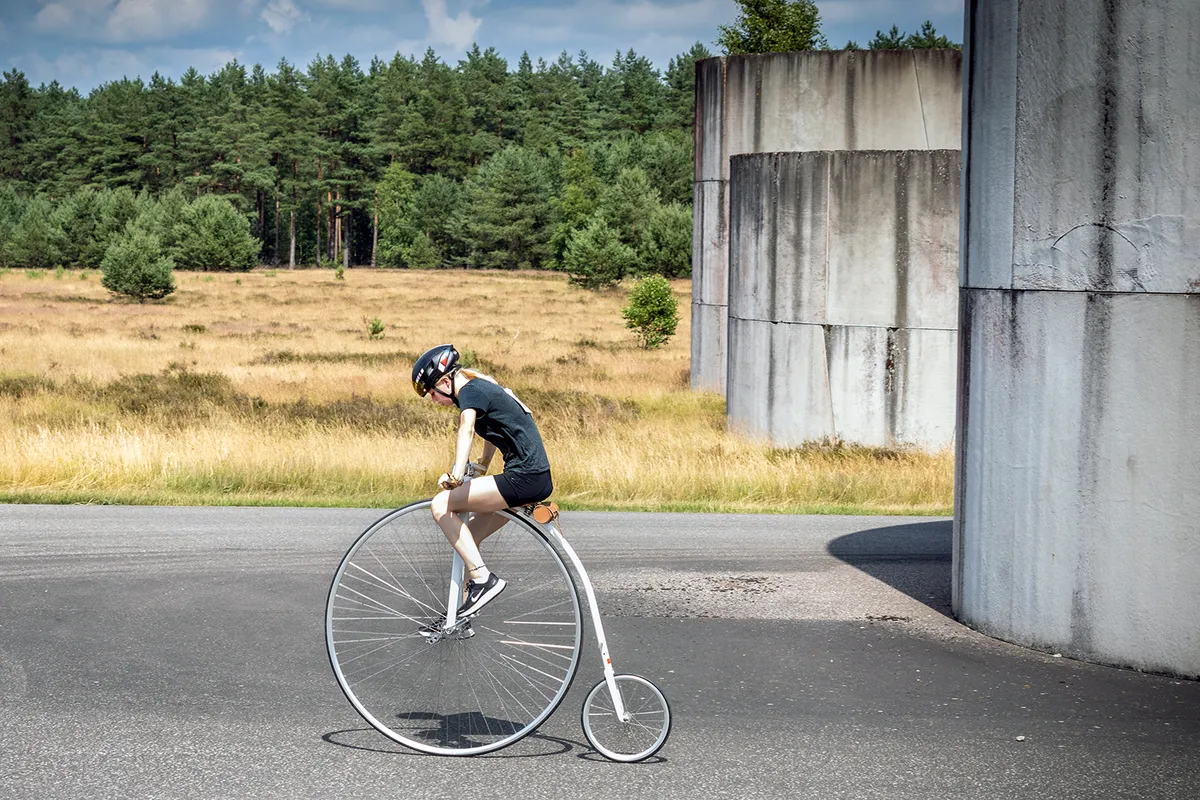
The first race was one of the ‘unofficial’ ones. The bikes were loaded on a truck and we cyclists took a seat in the bus that would take us to the start line.
We started at one-minute intervals, already sitting on the bike with the help of the starting staff who held the bike upright.
This was new to me because normally you stand behind your penny with your left foot on the peg over the small rear wheel and hold the handlebar. You then kick with your right foot, so the bike gets some speed before you step up, sit in the saddle, find the pedals and pedal away.
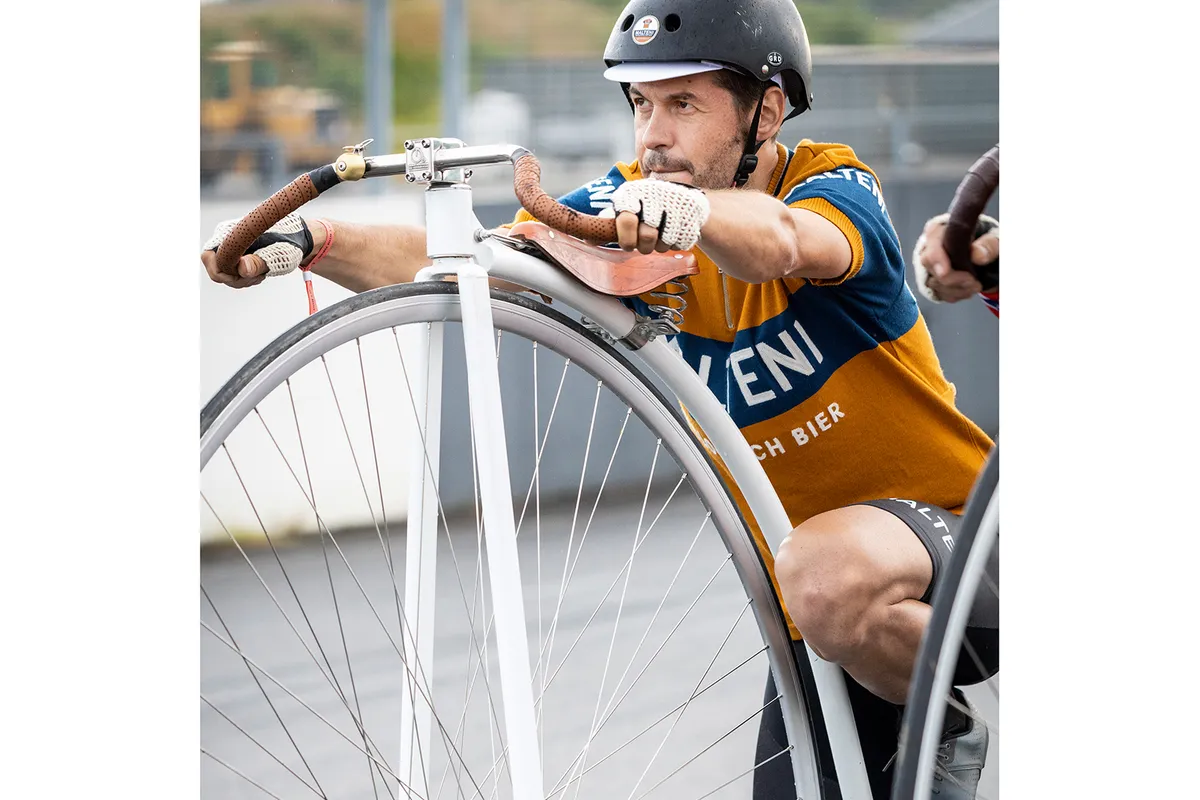
It was unusual, but the usual method is an easy way to lose time, so being clipped into my SPD pedals already had the potential for me to let my legs do the talking.
Three-two-one, and I was away, for what would be essentially an FTP test on a big wheel.
I didn’t go too hard at the start because the course was quite hilly. The penny-farthing can really move on the flat, but when it gets hilly it’s rather useless, and it’s not difficult to understand why.
A 54-inch front wheel driven by 125mm crank arms moves sluggishly uphill and here it meant my cadence varied between 50 and 150rpm.
Quickly I reached my max effort for the course and tried to hold it together as best I could.
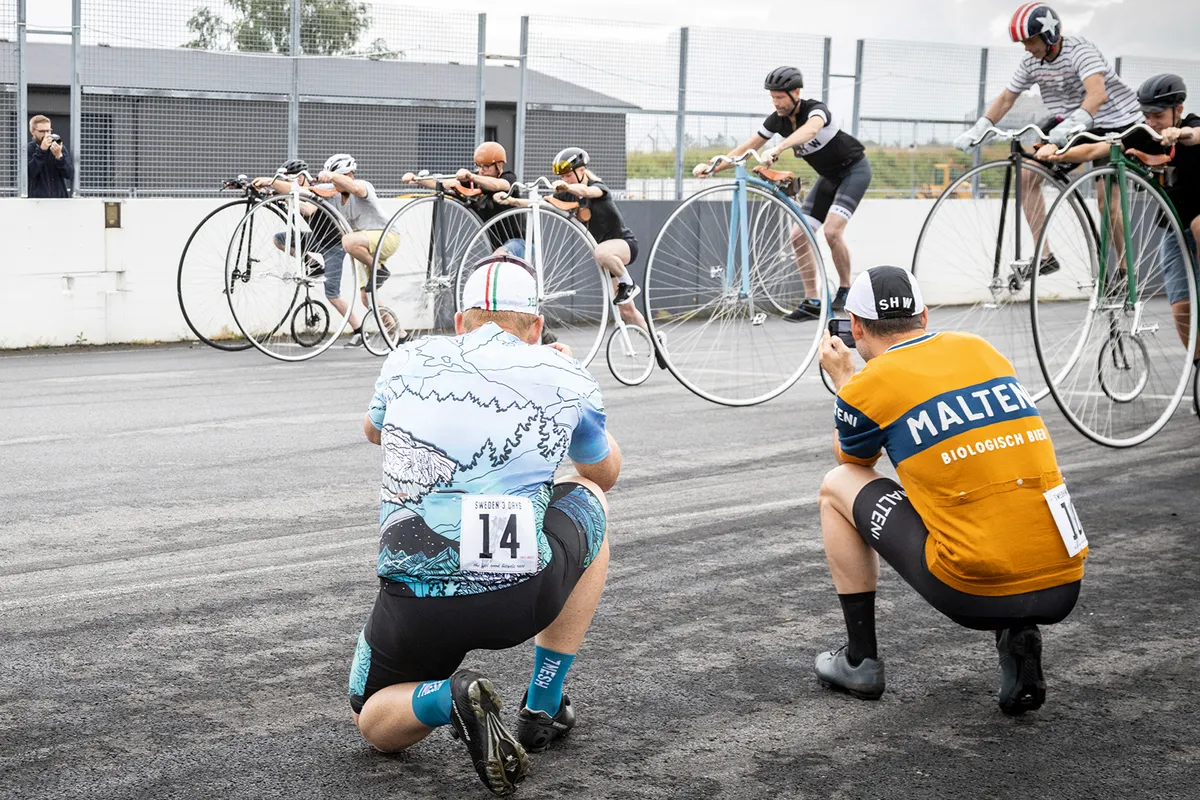
People living along the road and probably some travelling spectators had come together on the roadside. Some sat and had coffee, others were busy photographing the spectacle.
I managed to pass a few riders who’d started ahead of me, and I pushed as hard as I could in the headwind towards the line.
This was the first time that I’d competed against other high-wheel cyclists, and it was very exciting to compare the times afterwards, partly for this race, but also for what was to come. The result exceeded my expectations.
The Frenchman Alexandre Voisine outclassed the rest of us with 19:18. Behind him was tight. I had 20:20, Oskar Henriksson 20:21 and Pelle Kippel 20:26.
After the flower ceremony, France’s national anthem and coffee, we loaded everything and rolled towards food, rest and recharging before race two later the same evening.
Race two – 2km circuit race, Sturup Raceway
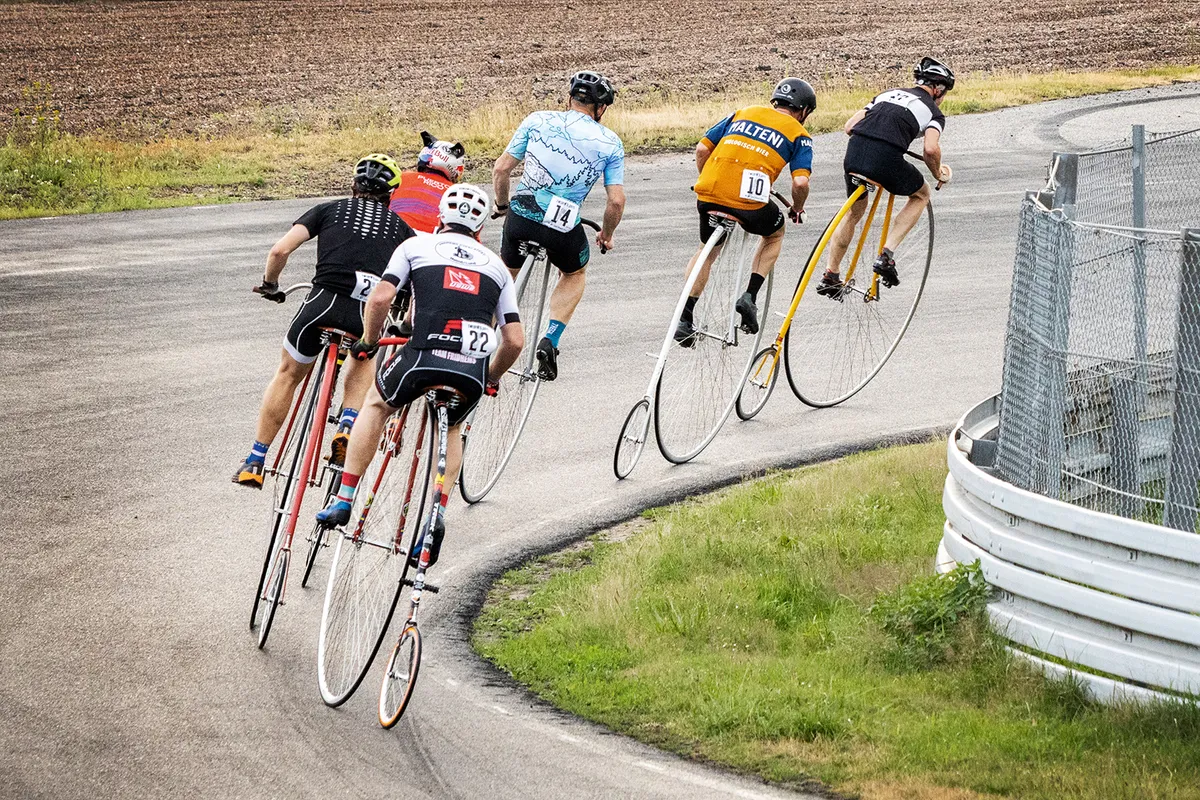
Beforehand, I was a little worried about the circuit races. Riding tight with other penny-farthing riders, in a peloton, chasing positions and sprinting, was new both to me and some of the other cyclists. A crash from such a lofty position ends badly more often than not.
The lap at Sturup measured a little over 2km. To begin we ran a qualifier over four laps with all the riders, and the first eight finishers would progress to the ‘A’ final.
I tried to conserve energy, held back and tried to get a feeling of the racetrack. There were some tight curves that were challenging at high speed.
In the B-final, my roommate Gustav went hard from the start and was able to win from the front without anyone catching him.
Before the A-final there was a sprinkling of rain and we were a little worried that it would be slippery, but there was enough grip. In the early stages of the eight-lap race, a group of five cyclists formed – Alexandre, Oskar, Pelle, Mattias Nordström and me.
I tried to be tactical, avoided the front and saved my power. Cycling away from Alexandre felt impossible after the individual time trial and my only chance in advance felt like betting everything on the sprint.
I knew I had a decent kick on a modern bike, but I had no idea how the legs would stand in this highly unusual context.
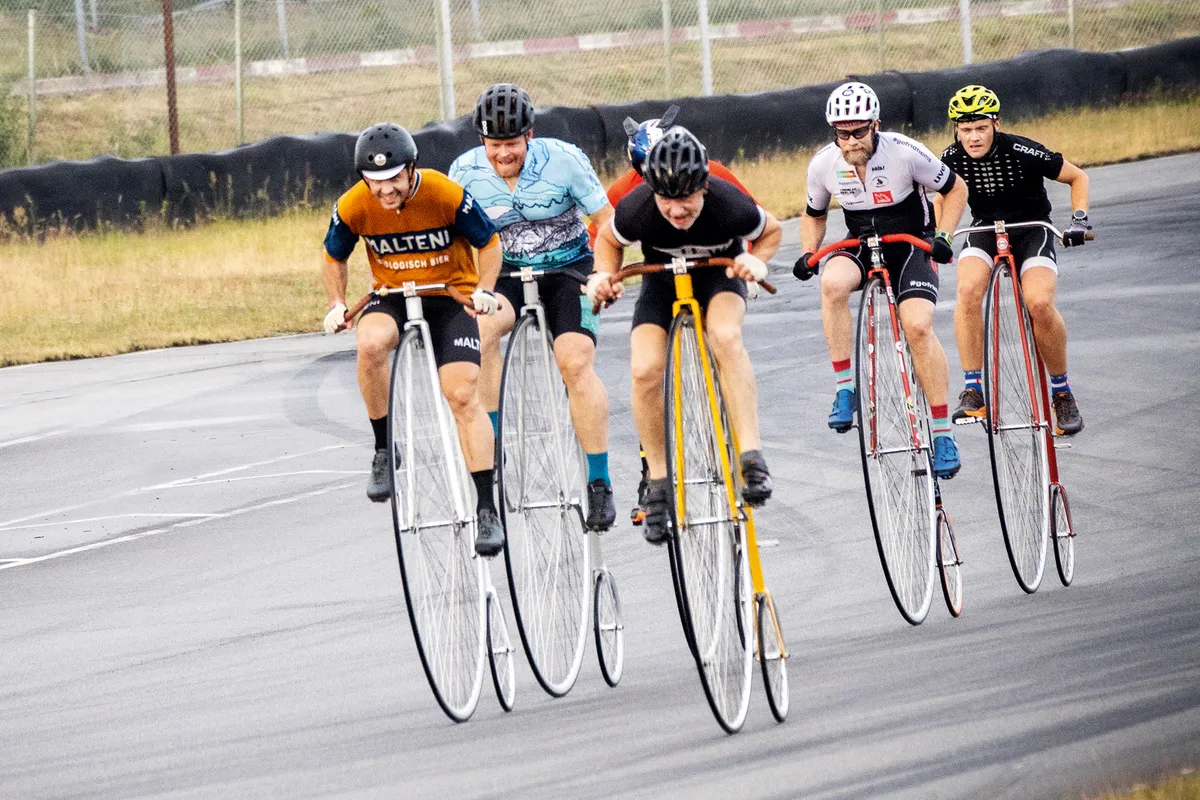
The small peloton held together until the last lap when it cracked up a bit, Pelle miscalculated the laps and burned his matches one lap too early.
In the last corner, I sat perfectly on Alexandre’s wheels, I went hard with what I had and felt quite quickly that I had higher speed than the rest.
I won the sprint. It was tremendous fun and it was really cool to compete on a racetrack. Sturup Raceway, with its flat roads and easy bends, felt like it was built for penny-farthing racing.
Race three – circuit race, Ystad
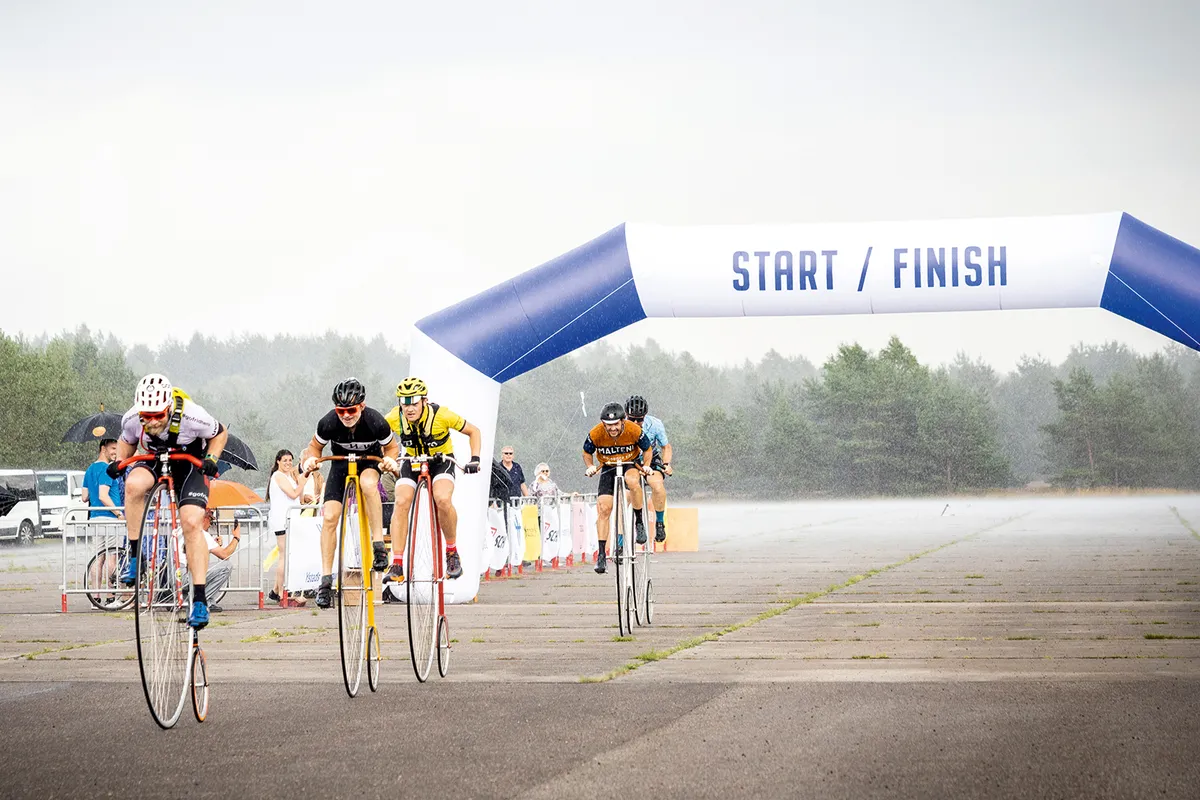
The sole race on day two was in the afternoon, so we used the morning for a social ride in Ystad, on the south coast, with ice cream and sightseeing.
A dozen high-wheel bikes undeniably attract interest, and it would be fantastic, in future years, to run a circuit race in the town centre on a hot summer evening.
We were happy to play the cards as they were dealt this year, which today was the rather less salubrious industrial area on the outskirts of Ystad.
The square track measured just over 1km and two qualifying heats over eight laps produced the 10 cyclists for the final. In that final, we rode 16 laps where again a small group of the same five cyclists as the previous evening formed.
This time we rotated a bit more in the group. Oskar and Pelle made some attempts to increase the pace and break the group without success.
There was a small climb where we had a headwind, so it was difficult to do anything. It would come down to a sprint again and, on this track, the finish was more challenging.
A short finishing straight, slightly downhill meant I had to start sprinting before the final 90-degree curve. According to Strava, I had 56km/h in the sprint and took the last curve at over 50km/h. I’ve never before taken a sharp curve at that speed on a penny-farthing, and it felt like the asphalt was about to run out before I got the bike around the curve. Again, I snatched victory.
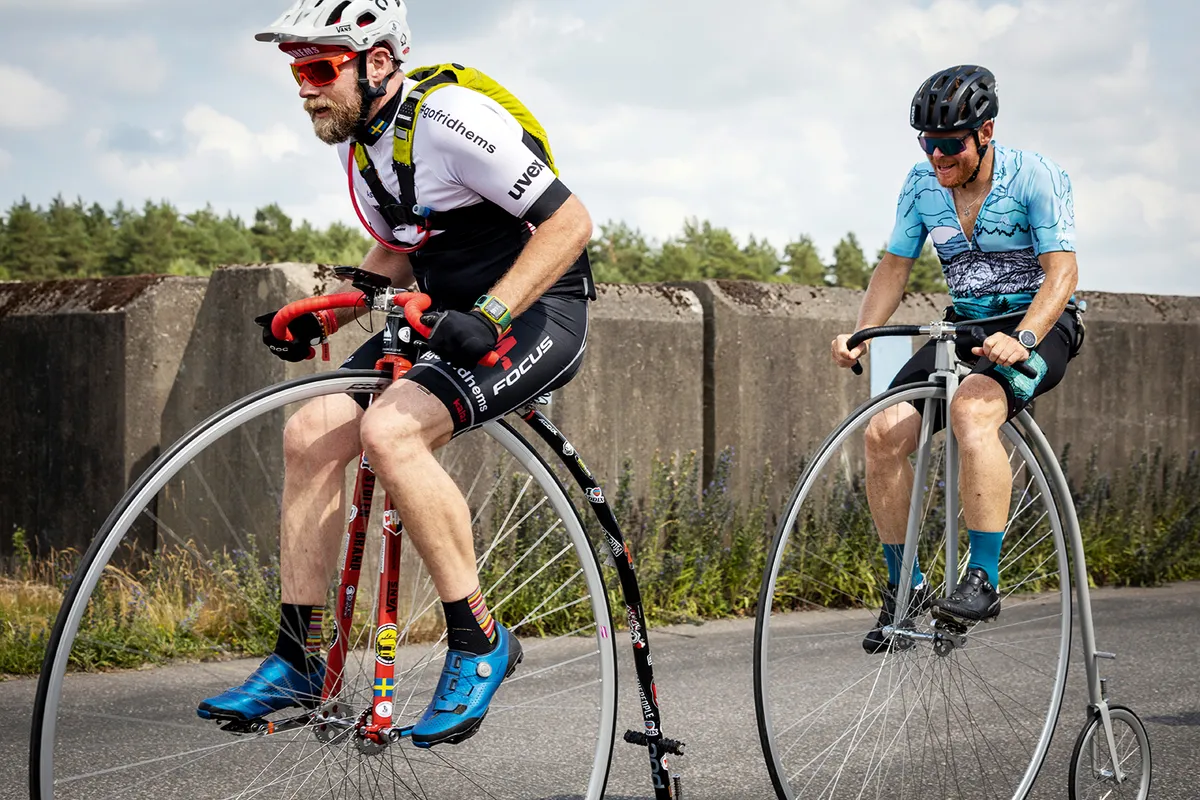
Race four, two-hour endurance race, Björka
Sunday and Sweden 3 Days would finish with a two-hour endurance race at the closed Björka military air base.
A 5km oval pan-flat course would be run as many laps as possible for two hours.
Ahead of the start, after what we’d experienced so far, it felt impossible that the group could be broken up early, but Pelle and Oskar seemed determined to try.
Right from the start, we set off at full speed. We rocketed along at just over 10 min/lap, almost 30km/h on average. That may not sound so fast for a roadie but trust me – it feels it up there.
My plan was to try to keep up and once again go for the sprint. Pelle did most of the work up front and when I got up there, I slowed down while Pelle and Oskar increased the speed when it was their turn.
This is how it went on for 12 laps, most of it in the sun, but on the last laps a heavy rain came and cooled us down.
In the last corner, I sat perfectly behind Alexandre and when the tempo picked up, I put the hammer down and managed to go past the other riders on the outside. I won again and, with this final victory, I had the great pleasure of winning the first edition of Sweden 3 Days.
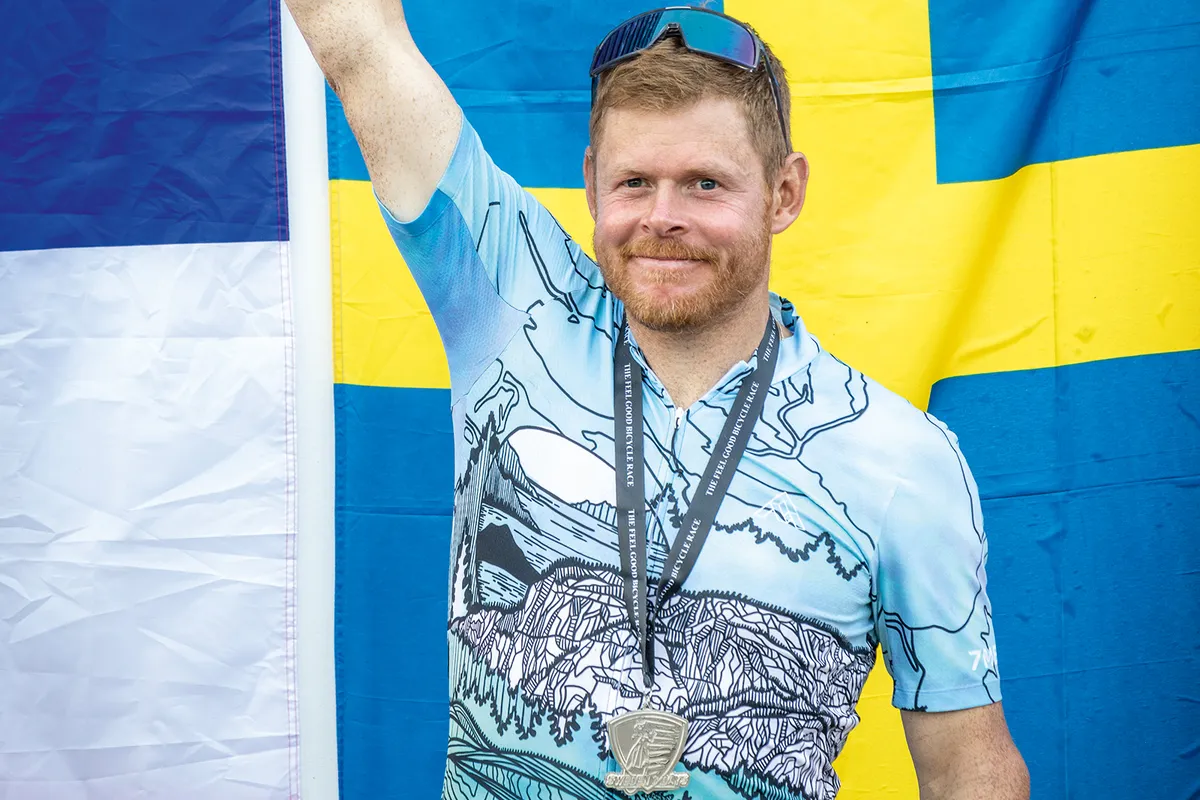
I have never had so much pain in my buttocks before, not even after the 4,200km long Transcontinental Race.
The upright position on the penny-farthing awards you with big pressure straight down into the sit bones. It’s almost impossible to stand up and release this pressure, which doubles the pain, especially in the longer races. Double cycling shorts is the consensus solution.
Sweden 3 Days has enormous potential as a cycling competition. It’s a completely unique event and seems to have suited both those who wanted to compete hard and those who had the goal to complete the four races.
The atmosphere among cyclists, crew, volunteers and spectators was absolutely fantastic and very familiar, something I’ve only experienced on a bicycle in the world of unsupported ultra-cycling.
For the audience, there’s currently one chance every year in Sweden to watch penny-farthing competitions. Hopefully, stages in the coming years can take place in towns and cities, which will encourage more spontaneous spectators to check it out. Roll on next year!
The next edition of Sweden 3 Days is set for 1 to 3 July 2022
Penny into pounds
How to get the hang of a 150-year-old bike
Today’s penny-farthings are a little lighter and roll a little better due to better tyres and bearings, but otherwise, they’re identical to the construction from the 1870s.
You choose the size of the front wheel on your penny-farthing according to how long your legs are. If you have strong legs, you can ride shorter crank arms, a larger front wheel and thus get a higher speed.
It’s a very stripped-down experience to ride a penny-farthing; there are no gears, no chain, basically no brakes and not even air in the tyres, which makes punctures impossible.
You sit as high as you would on a horse and get an incredible view compared to being on a standard road bike.
An early challenge is to get up and down from the bike, one that for most riders requires only a few hours of training.
Once you get up and start pedalling, it’s easier than you might imagine.
When you ride a penny-farthing, motorists usually hostile to standard bike riders suddenly become cycling fans, finding time to stop and take pictures, and cheer and wave.
As a high-wheeled cyclist, you must be prepared to be photographed and questioned about how to get on the bike, how to stop and more. If you want to ride your bike unnoticed, the penny-farthing is probably not for you.
Penny-farthing races are spectacular, even if the speed is not as high as in a road race with modern bicycles. It’s difficult to break a strong group and go for the breakaway, which will lead to tight races.
On top of that, it feels like the tactics from modern cycling apply to these races as well – power-saving and positioning are just as important.
The risk of crashing is always there and, because you sit so high, it feels like the risk of hurting yourself if you do come down is high.
The bike itself (and its construction) feels less crucial than on modern bikes and you can buy a competition-ready high wheel bike for about €1,600. What are you waiting for?
